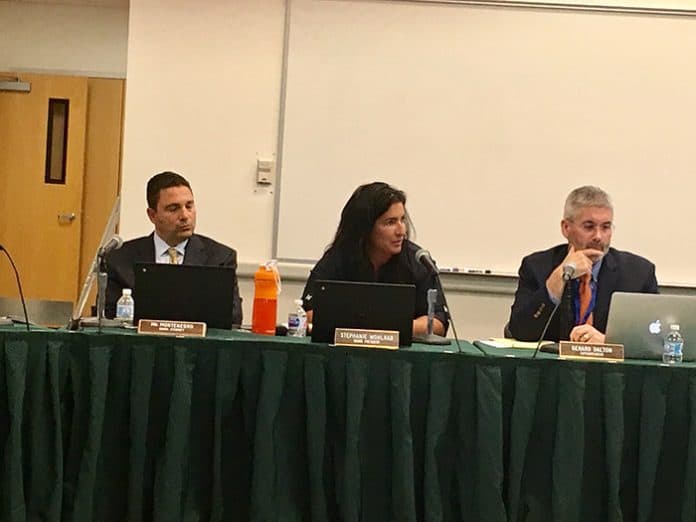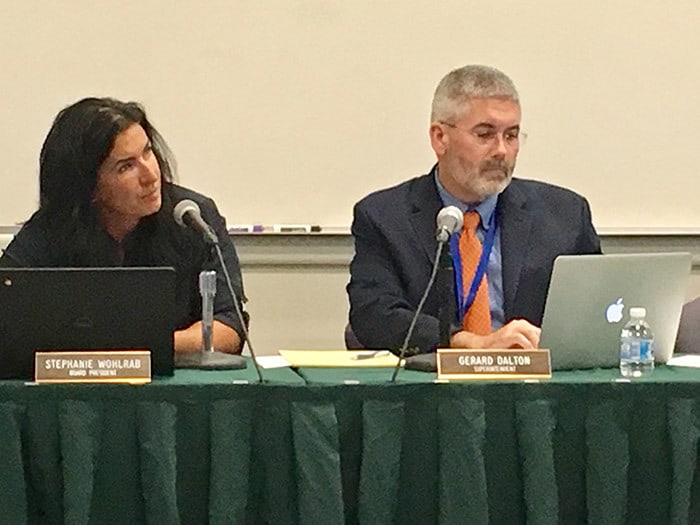
BRICK – The burden of making up for a $23 million loss in state aid to the school district over a seven year period would fall directly on the shoulders of Brick taxpayers, said School Business Administrator James Edwards during a special Board of Education meeting.
On July 13, Brick was notified that for the 2018-2019 school year, the district is facing a reduction in state aid of $1,162,224 for the first year.
In year two of the school funding plan Brick stands to lose $2,039,750. In the third year, $2,549,687. In the fourth year, $3,569,562; for year five, $4,589,437. Year six, $5,354,343; and for the final seventh school year, $6,119,249.
In a new school spending plan proposed by New Jersey Senate President Stephen M. Sweeney, and signed by Governor Phil Murphy, aid would be cut to districts that are considered to be overfunded, so those districts would be mandated to raise taxes to the 2 percent cap each year, but it still won’t make up for the shortfall, Edwards said.
The 2018-2019 Brick school year budget had to be approved by the Board of Education by Aug. 1.

This is the second year the district has faced a reduction in state aid. Last year, the state was going to cut $750,798. The district appealed it, citing hardship due to the loss of tax ratables from Superstorm Sandy. The state reinstated that aid, but for last year only. That $750,798 is also to be cut for the upcoming year. Therefore, when the two cuts are added together they total $1,913,022.
Superintendent of Schools Gerard Dalton said the district would once again appeal for similar temporary reinstatement of the aid reduction once the application for appeal becomes available.
To make up for the shortfall in the 2018-2019 school year budget, the Board would be utilizing $1,348,276 in surplus and reducing costs by $564,746. (About $1.5 million is left in the reserve fund, Edwards said).
There would be no layoffs this year, Edwards said, but a number of unfilled administrative and teaching positions would not be filled. Earlier this year, 44 positions had already been cut by attrition.
“This is an emergency,” Dalton said. “We went over all the line items and we already had a tight budget. We couldn’t come up with that amount of money.”
That’s true, said Board of Education President Stephanie Wohlrab.
“We had to respond and react to a budget crisis,” she said. “We did without some of these [teaching and administrative] positions for a long time. We’re not taking away anyone’s job.”
She said the most important thing the Board and the school administration is keeping in mind is what is best for the students.
“Tough decisions will have to be made over a longer period of time. We are all concerned about how this will impact the children,” she said.
Edwards said the district would have “draconian” cuts totaling $23 million over the next seven years.
“We don’t have an expenditure problem,” he said. “The Department of Education says we don’t spend enough on our students, and the [senate] bill requires a 2 percent tax levy increase.”

According to the state spending plan, Brick taxpayers should be paying $129,909,386 for schools, but the amount actually raised totals $107,405,879, which is $22,503,507 less than the formula says local taxpayers should be paying.
The state is not going to fund districts that are not funding their own schools and not meeting the adequacy number, Edwards said.
A formula that is based on a four-digit code on income tax returns assigns a taxpayer their municipality and combines it with real estate value to determine how much the district can afford, Edwards explained.
“How is this fair to Brick taxpayers that we are considered wealthy? Princeton is getting $4 million more. How is that fair?” he asked.
Wohlrab said the Board and the administration is working and talking about what they can do next.
“Brick is a strong community with people who have been here a very long time. We are going to turn this around to the best of our ability,” she said.







